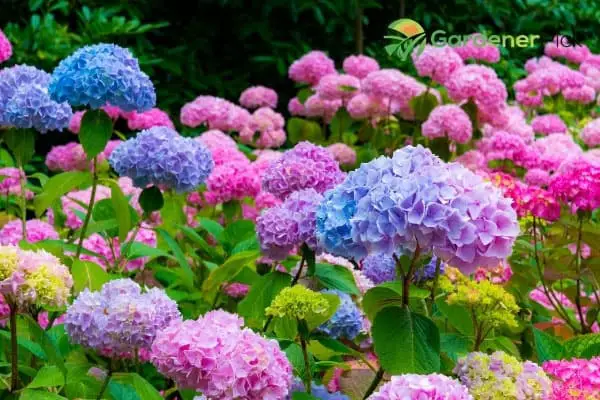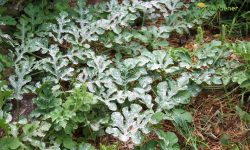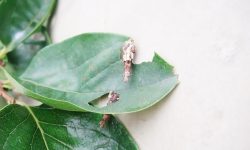Are you interested in germinating Hydrangea seeds in your garden? Have you any idea about how to grow them?
If you love gardening, you must accept the challenge of growing these easy-care plants from seeds because they will add value to your garden.
In this article, we are going to share all the info about Hydrangea Seeds. If you want to add these wavy blossoms to your garden, don’t go away and read this article till the end.
Let’s explain briefly about Hydrangea seeds. These are the tiny seeds of a flowering plant with the common name Hydrangea. Normally, this plant can grow by cloning, propagating, and sowing seeds. These seeds take about 14 days to germinate. The best time to grow these seeds is early fall and spring. The flowering season is from early spring to late autumn and the color of flowers is red, white, blue, and pink.
Mostly Hydrangea plants are shrubs ranging from 1 to 3 meters tall, trees, and vines. The word “Hydrangea” originated from a Greek word, which means “water vessel”. The reason for this naming is the shape of its seed pods that look like water jugs. Its showy flowers grow at the end of the stem forming a beautiful pattern. Moreover, its root and rhizome are used in the preparation of the homeopathic tinctures to treat urinary tract diseases. However, it should not be consumed directly due to the presence of cyanogenic glycosides that may be toxic.
To know more about hydrangea seeds, keep reading!
Table of Contents
Do Hydrangea Grow from Seeds
Mostly, gardeners keep on asking if hydrangea plants can be grown from seeds? The short answer is yes, they can. Though it can be a headache as it requires a lot of wait and effort. But the end result will be super as the new plants will be unique in properties and color.
On the other hand, the plant that grows as a result of cloning usually maintains the features of the mother plant. Moreover, each new plant that grows from seeds itself is considered as a cultivar. Once the seeds are grown, they need little care and can tolerate every soil type.
Normally, seeds are produced in the blooms of hydrangea plants. These seeds are too small, even they can be mistaken for dirt. Therefore, care should be taken while handling them as they can disappear in the wind.
Do Hydrangea Grow from Seeds or Bulbs
Yes, hydrangea can grow both from seeds and bulbs. Though the seeds are too small, that’s why they need proper care till germination. Plus, they are easy to manage indoors. What you have to do is simply spread the seeds in a pot or flat filled with the potting soil. Also, make sure to keep the flat moist, in a sunny place, and away from the wind. The seeds will take 14 days to germinate.
However, hydrangeas also grow from bulbs. The best time for planting is spring after the last spring frost and fall before the first frost fall. Let’s read the following steps for growing hydrangeas from bulbs.
- Dig a hole having a depth of the size of the root ball and 2 to 3 times wider.
- Put the plant bulbs in the hole and half cover it with soil.
- Fill the half-covered bulb with water.
- Once the water is absorbed, fill the next half hole with soil and water.
- They grow rapidly and increase height by 15 feet.
How Long Hydrangea Takes to Grow
Generally, hydrangeas are rapid growers. They can grow up to 15 feet in height. These showy flowering plants grow themselves and fill your garden space just in one summer. They produce blooms in spring that last throughout the summer and early fall.
However, it mainly depends on your type of cultivar and planting zone. The newly grown hydrangeas that have formed buds in early summer, will bloom in the following spring, summer, or fall season. Too hot or cold weather can stop blooming until the conditions become favorable.
If you are growing hydrangea from seeds, it will take 14 days to germinate. The best season for planting seeds in fall followed by early spring. The early morning or late afternoon is the best time for planting these seeds. Depending on the time of seeds sowing, the new hydrangeas will bloom for 6 to 8 weeks in the summer.
How to Grow Hydrangea Seeds?
Are you ready to accept the challenge of growing hydrangea from seeds? If yes, put on your garden gloves and read the tips below carefully. Firstly, you need to collect seeds and it is a bit tricky.
- For seeds collection, a hydrangea blossom is needed.
- In addition to small showy flowers, hydrangea blossoms consist of tiny sterile and fertile flowers. The seeds present in the fertile flowers are required.
- For this purpose, you have to wait until a blossom fades, put a paper bag on it and allow the blossom to dry completely under the bag.
- Cut the stem and put the bag aside for a few days until it dries completely.
- Carefully shake the bag, tiny dust-like seeds will get out of the blossoms.
- After harvesting seeds, you can sow them right away.
- Seeds should be stored in a paper bag if you need storage just for a season. Place the paper bags in a sealed jar in a cool and dark place.
10 Steps of Growing Hydrangeas from Seeds
Well, the seed collection step is completed. Next, you have to plant these seeds. Read the below-mentioned 10 steps carefully to know how to grow hydrangea from seeds.
- Take a flat filled with potting soil either vermiculite or perlite.
- Moisturize the potting soil in the flat.
- Surface sow the seeds on the flat. Just sprinkle the seeds, don’t mix them with soil.
- Cover the flat with plastic wrap to retain the soil moisture.
- Place the flat at a bright shady location, avoid placing in direct sunlight.
- The seeds will take 10 to 14 days to germinate.
- Take 1-gallon potting containers to transplant the hydrangea seedlings.
- Fill the containers with potting mix preferably the mixture of peal and organic compost.
- When the plants develop three to four healthy leaves, transfer them to the potting containers.
- Now place the pots in an outdoor shelter with the morning sun and shady afternoons. This will allow the new plant to adjust outdoors and establish a good root system before transferring to the lawn.
How to Propagate Hydrangeas
Yes, you can easily propagate Hydrangeas as they can develop roots from the stem when buried.
Look at the steps below to learn the procedure.
- Select a newly grown branch of your established Hydrangea plant that has not flowered yet.
- Dig a pit in the ground near the branch. Bend the branch so that it touches the soil in the middle of the pit.
- Put some scratches on the stem where it is touching the ground. The roots will develop from these cuts.
- Now cover the pit with soil and put a stone on it.
- After the new roots are established underground, this new plant can be transplanted to a new location.
How to Care for Hydrangea plants?
Let’s have a look at the hydrangea care tips below:
- The water requirement for hydrangeas in the growing season is 1 inch per week. Deep watering is needed 3 times per week to promote root growth. You can use a soaker hose for deep watering effectively.
- For hot areas, adding organic mulch underneath hydrangeas is critical for moisture, soil improvement, and cooling.
- Each specific hydrangea requires fertilizer based on its needs. For example, big leaf hydrangea will benefit from applying light fertilizer in March, May, and June. Oakleaf and Panicle Hydrangea need fertilizer twice in April and June. While smooth hydrangea needs only one fertilizer application in late winter.
- Pest can attack your hydrangea when it is stressed. Common diseases that these plants can experience are powdery mildew, wilt, and leaf spot. So, care properly to avoid this situation.
Read our Cantaloupe Seeds 101 Guide from here
Do Hydrangeas Come Back Every Year?
Are you excited after planting hydrangea seeds and waiting for the blooms? Don’t worry, your effort will not go waste and hopefully, you’ll see the flowers the same year. Let’s explain it briefly.
Depending on the blooming, hydrangea plants are divided into two groups.
Panicle Hydrangeas and Smooth Hydrangeas are included in the group that blooms on new growth each year. There are more chances of blooming for the plants that have developed buds in early summer on new growth. These established plants will require no care and come back every year.
The other group includes Oakleaf Hydrangeas and Bigleaf Hydrangeas. In the cooler climates, these plants can be challenging as they set flower buds in the fall. Their buds are mostly prone to get damaged by excessively cold temperatures resulting in inconsistent or no blooming at all.

Hardiness Zones for Growth of Hydrangeas
Have you any idea about the importance of the hardiness zones in the growth of hydrangeas? For new gardeners, let’s explain first what are hardiness zones? It actually refers to the favorable climate for a specific plant in an area.
The U.S Department of Agriculture has given numbers to areas with low and high temperatures. For hotter climates, higher numbers are given. For example, the tropical areas of the country are given hardiness zones of 10 and 11.
Commonly, four species of Hydrangea out of the 23 hydrangea genus are cultivated in the U.S.
These are described below:
- Oakleaf Hydrangea
- Panicle Hydrangea
- Smooth Hydrangea
- Bigleaf Hydrangea
Below are the hardiness zones for different species of Hydrangea. Have a look to know more:
Hardiness zone 6 and 7: In the temperate climates, having hot summers, cool winters, and wet spring and fall the hardiness zone is 6 and 7. All five species of Hydrangea grow well in this zone. For zone 6, the average minimum temperature is -10°F, and in zone 7, it is 10°F
Hardiness zone 3: The panicle hydrangea can tolerate the hardiness of the USDA zone 3. The average minimum temperature of this zone is -35°F.
Hardiness zones 7,8,9: The average minimum temperature of the USDA zone 9 is 25 to 30 °F. It includes the northern parts of Texas and Florida. Oakleaf, Bigleaf, and smooth hydrangeas can grow well in USDA zone 9, Climbing hydrangeas grow well in zone 7, and panicle hydrangeas in zone 8. Bigleaf hydrangeas like the zones 6 through9.
Types of Hydrangea for Your Garden
Are you anxious to learn about the types of Hydrangea best for your garden? If yes, then your wait is over. We have mentioned the list of best hydrangeas with hardiness zones, you can select accordingly.
| Types | Shape of Blooms | Hardiness USDA zones | Images |
| French Hydrangea | Large vibrant blooms | 5 | |
| Mophead hydrangea | Small flowers in big rounded clusters | 5 through 9 | |
| Lacecap hydrangea | Flat disc-like clusters edged with large showy flowers. | 6 through 9 | |
| Endless Summer hydrangea | Unique bigleaf hydrangea | 4 through 8 | |
| Peegee hydrangea | Cone-shaped panicles | 3 through 8 | |
| Blue hydrangea | Large blue blooms. | 6 through 9 | |
| Pink hydrangea | Hot pink large vibrant blooms | 3,4,5,6,7,8,9. |
Where can you buy Hydrangea Seeds?
Are you wondering where to buy hydrangea seeds? Don’t worry, It is the era of online purchases and Amazon is the best place to buy hydrangea seeds. We have mentioned a variety of these seeds available on Amazon. So, have a look if you want to buy them.
Mixed Hydrangea Seeds: The mixed colors hydrangea seeds are available on amazon. These are best to grow in pots or ground having a 95% budding rate. These are low maintenance and easy to grow seeds with radiation absorption quality.
Vanilla Strawberry Hydrangea seeds: The unique vanilla strawberry hydrangea is a must-try for your garden. These seeds are easy to plant in pot and ground and produce cone-shaped pink and white glorious blooms.
Pee Gee Hydrangea Seeds: You can purchase Pee Gee Hydrangea Panicle seeds from amazon. These seeds produce white and pink flowers and the hardiness zone is 3_9. The blooming time for these hydrangeas in summer and fall. The height of these hydrangeas can reach from 15 _25 inches.
White Hydrangea Seeds: The Native Hydrangea Arborescens seeds give huge beautiful white blooms. These seeds have a hardiness zone 4_6 and height 36 – 72″. These hydrangeas attract bees and are tolerant to weather.
Hydrangea 101- A General Overview
Final Words
So, the final words are, hydrangea seeds are easy to grow, maintain, and require minimum care once established.
They grow to produce blooms in a variety of colors. You can easily clone and propagate hydrangea plants. Consider planting heat and disease-resistant seeds. The most cultivated species in the U.S are Oakleaf, Bigleaf, Panicle, and Smooth Hydrangeas.
Hopefully, by reading this info, you’ll be able to grow hydrangea seeds easily at home.





![How Long Does Sevin Dust Last? [Minimum Time For Working Fast]](https://gardenerpick.com/wp-content/uploads/2022/01/how-long-does-sevin-dust-last-250x150.jpg)
![What Do Inchworms Turn Into? [Life Cycle]](https://gardenerpick.com/wp-content/uploads/2022/07/What-Do-Inchworms-Turn-Into-250x150.jpg)